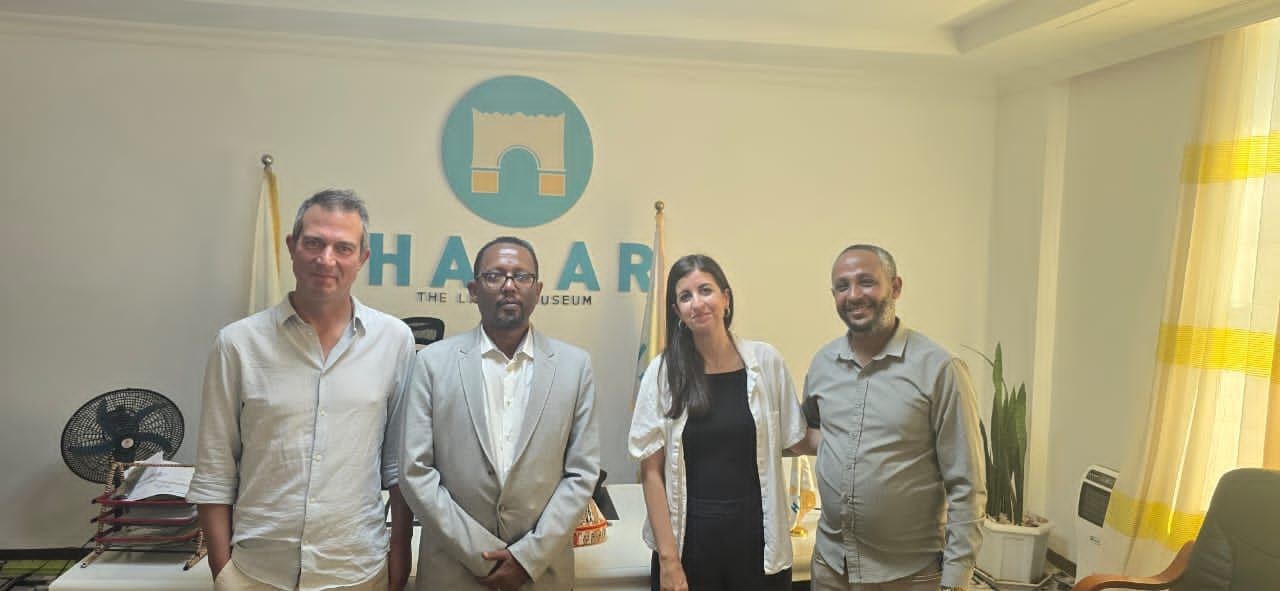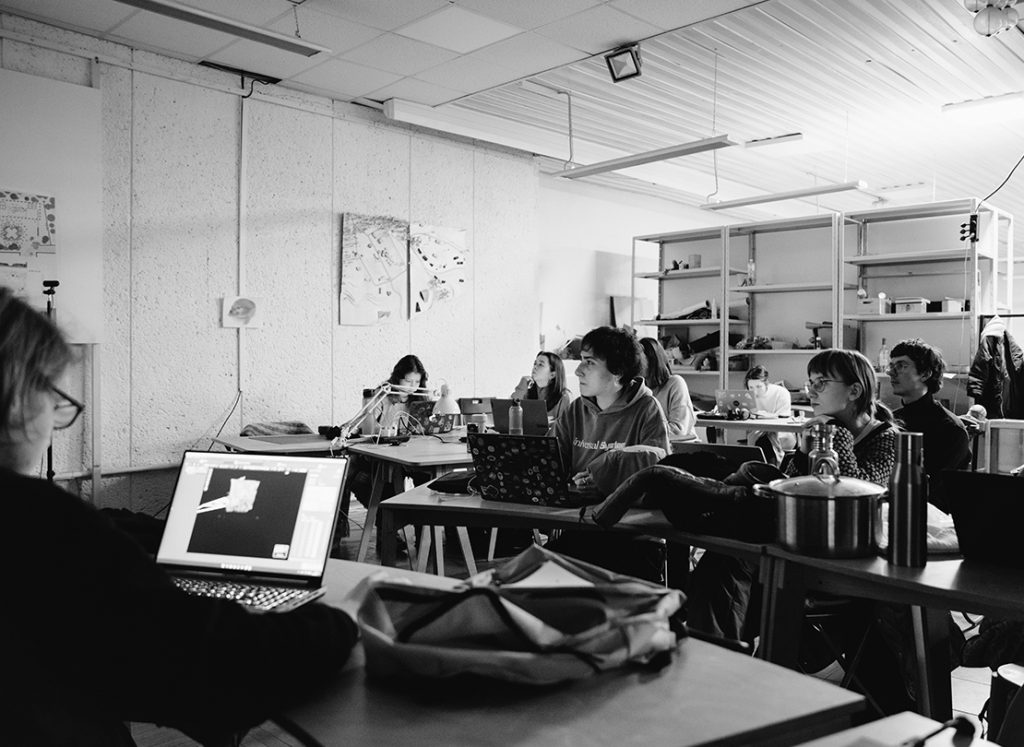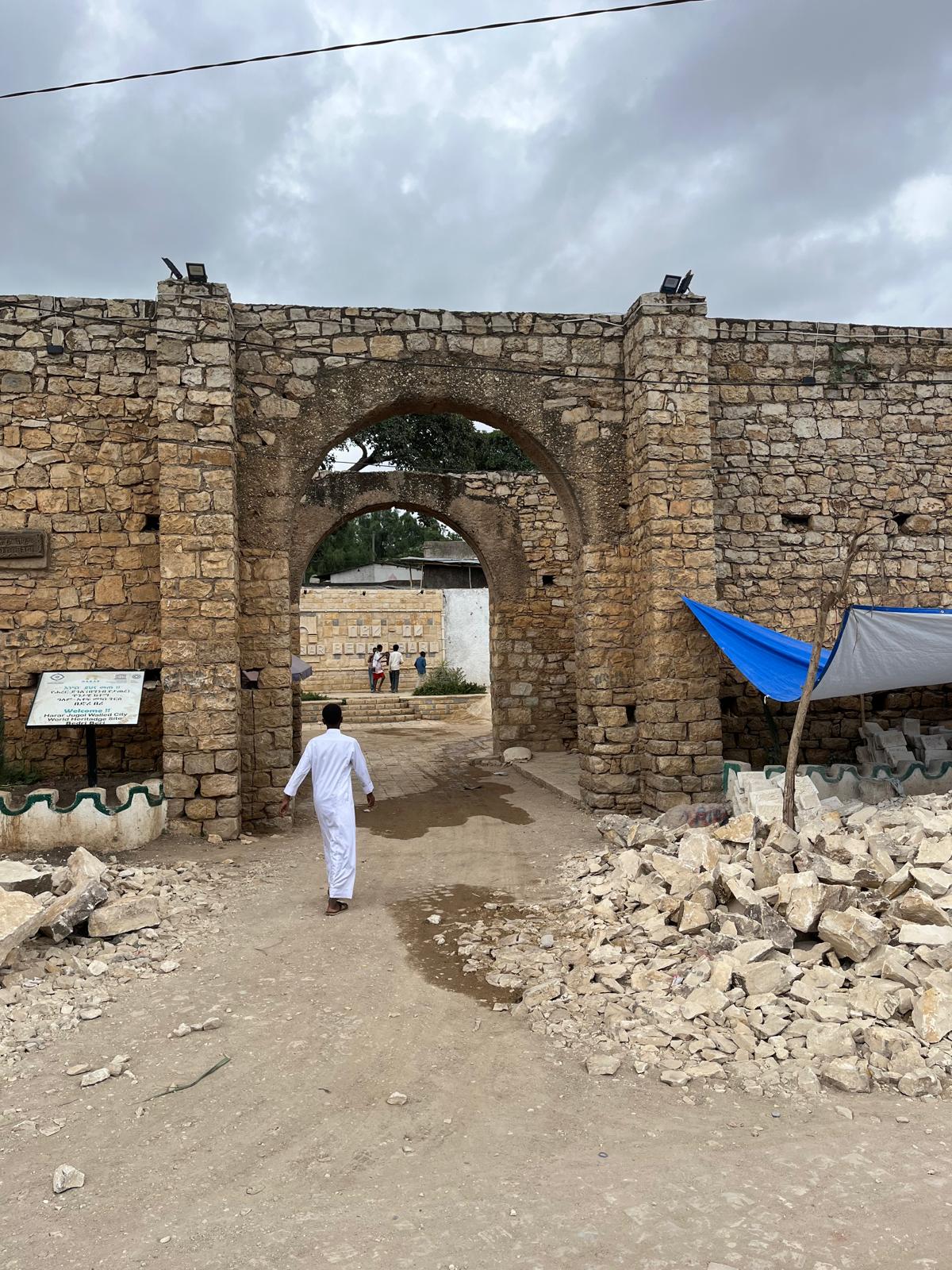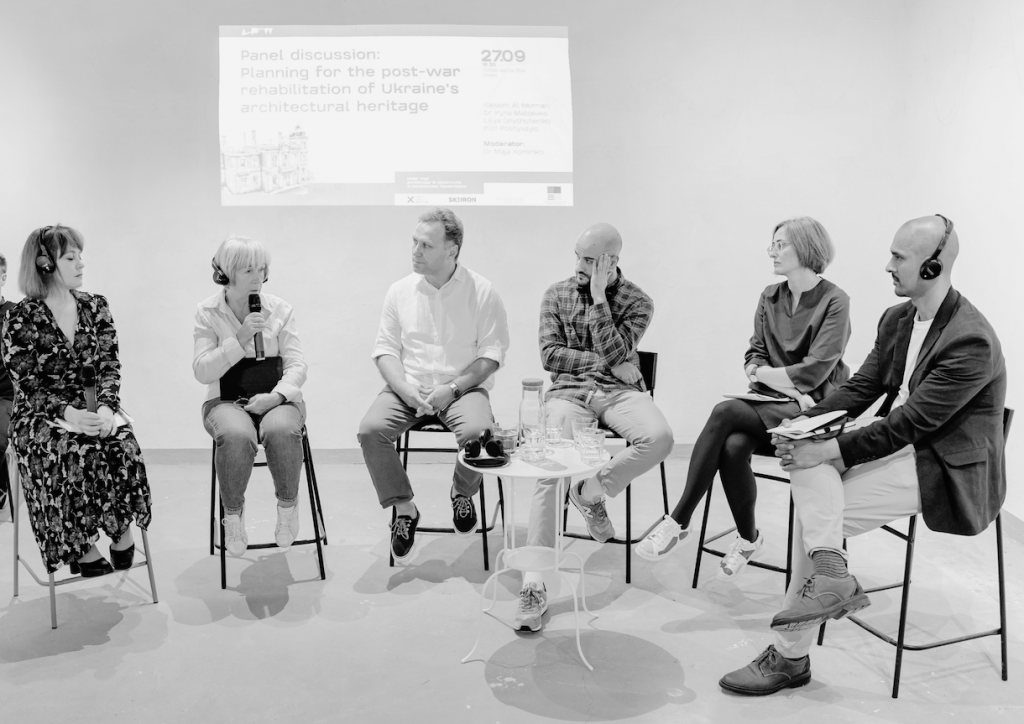Tag Archives: architectural heritage
Reflections on a year of Architectural Heritage Preservation in Times of War: The Ukrainian Model
In times of war, when destruction seems to rewrite the physical and cultural landscape of a nation, a different kind of architecture emerges – one built from knowledge, skill, and an unyielding commitment to protect memory. The project “Architectural Heritage Preservation in Times of War: The Ukrainian Model” stands as a powerful example of what can be accomplished when education, resilience, and international collaboration converge with urgency.
Launched in September 2024 by HERITΛGE in collaboration with the Kharkiv School of Architecture (operating from Lviv) and 3D documentation experts of Skeiron, this project set out to train a new generation of heritage architects and educators equipped with the technical and ethical tools needed to preserve Ukraine’s imperiled architectural heritage.
Building knowledge amid collapse
As buildings fall and monuments come under attack, the project focused on something less visible but deeply enduring: education. Over the course of the academic year, it reached 30 students and 10 educators from across Ukraine – Chernivtsi, Dnipro, Kharkiv, Kherson, Poltava, Zaporizhzhia, Kyiv, Odesa, Lviv and Vinnytsia regions – through an intensive curriculum that merged theory with fieldwork. Topics ranged from cutting-edge techniques like photogrammetry and 3D laser scanning to international conservation standards and legal frameworks.
Field internships in Western Ukraine led by Skeiron gave students hands-on experience in documenting heritage sites. They produced high-resolution digital scans and architectural records that now serve both as tools for future conservation efforts and as acts of cultural preservation in their own right.
In parallel, the programme’s educator training combined online learning with in-person workshops coordinated and hosted by the Kharkiv School of Architecture and practical exercises. This dual approach enabled participating teachers to develop their own heritage-focused curricula – tailored to their institutions – and expand the reach of conservation education across the country.
The urgency of this work is echoed in the April 2025 report “The Ukrainian Cultural Sector in Wartimes: Emergencies – Needs – Measures”, which highlights a critical shortage of qualified professionals in conservation, restoration, and heritage protection. The report calls for systemic investment in education, especially in frontline regions where remote-only instruction has left gaps in competencies. Against this backdrop, the project addressed not just a wartime emergency, but a long-standing structural need for enhanced education in architectural heritage conservation.
The project’s broader legacy
Though limited to one academic year, the project’s impact far outstrips its timeline. It catalysed the development of a reproducible curriculum, created a set of digital documentation of 15 heritage sites, and introduced conservation methodologies to institutions that previously had limited access to such tools. Perhaps most importantly, it demonstrated how cultural preservation can be reframed as a form of resistance and recovery.
A series of public webinars and lectures – featuring experts from Ukraine and abroad – helped bridge gaps in knowledge and connect students and instructors with global heritage preservation communities. The programme didn’t just train students; it helped cultivate a network of professionals who carry forward the mission of architectural conservation with firsthand experience and shared purpose.
A call to sustain what was started
Despite its success, the project ended in 2025 due to funding limitations. Its early closure is a sobering reminder of the fragility of cultural preservation efforts in conflict zones. Yet it also underscores a core truth: the preservation of architectural heritage is not a one-off intervention. It is a long-term commitment that demands sustained investment, institutional backing, and policy support.
The tools have been built. The knowledge has been shared. What remains is the will to continue – through new programs, policy reform, and the support of international allies.
Final thoughts
In Ukraine today, every carved facade, every war-scarred cornice tells a story – not only of destruction but of survival. The “Architectural Heritage Preservation in Times of War” project ensured that these stories are not lost. As Ukraine continues its path through war toward recovery, the architects trained through this programme will stand among its quiet heroes – those who understand that rebuilding is not just about walls, but about the memory those walls hold.
Now, more than ever, we must ask: what kind of future do we build if we let the past be erased?
Find out more about our projects here.
Building Local Capacity for Heritage Conservation in Harar Jugal, Ethiopia
by Xanthippi Kontogianni, Ethiopian Program Manager, HERITΛGE
Harar Jugal, the fortified historic town recognized as a UNESCO World Heritage Site, stands as a living testament to Ethiopia’s rich cultural and architectural heritage. With its intricate alleyways, traditional Harari houses, centuries-old mosques, and lively open markets, Harar has long served as a cultural and commercial melting pot. The town holds immense historical value while simultaneously serving as a vibrant home for its local community. However, the preservation of this unique urban landscape is increasingly threatened by urbanization, inadequate maintenance, and the impacts of climate change.
To both leverage Harar Jugal’s potential for the benefit of its contemporary inhabitants and safeguard the historic center for future generations, there is a pressing need to develop specialized skills in heritage conservation, traditional building techniques, and sustainable urban management. Strengthening local capacity in these areas is essential to ensure that the cultural and historical integrity of Harar remains intact while responding to the evolving needs of its residents.
Walls of Harar Jugal.
In December 2024, the Culture and Tourism Bureau of Harar, one of the key institutions responsible for managing the Harar Jugal historic town, invited HERITΛGE to a virtual meeting. During the meeting, Mohammed Rabi, a representative of the Bureau, proposed organizing a heritage conservation workshop for Bureau staff and close collaborators. In alignment with its mission to train and empower heritage professionals to engage communities in stewarding their cultural assets for greater understanding, sustainability, and economic development, HERITΛGE welcomed the initiative and agreed to deliver the proposed training in Harar.
The workshop on Heritage Conservation was conducted in a blended format, combining online and in-person sessions held on 7-9 and 21-23 May 2025, respectively. This flexible format ensured accessibility while supporting dynamic, participatory learning. The training was led by Alexis Stefanis, Assistant Professor of Architectural Conservation at the Department of Conservation of Antiquities and Works of Art, University of West Attica. The curriculum was structured around three core content areas: General Principles of Cultural Heritage Conservation, First Aid for Finds, and Preventive Conservation. The online component delivered core theoretical content through lectures, readings, and discussions, while the in-person sessions emphasized hands-on exercises, group work, and live demonstrations. The workshop attracted 13 participants (8 men and 5 women) and was delivered under HERITΛGE’s HerMaP Ethiopia training program, which is funded by the Humanities in Place initiative of the Mellon Foundation.
 Networking meeting with Mr Teweleda Abdosh Ahmed – Head of Culture, Heritage & Tourism Bureau, Harari People Regional State.
Networking meeting with Mr Teweleda Abdosh Ahmed – Head of Culture, Heritage & Tourism Bureau, Harari People Regional State.
Participant engagement was enthusiastic and highly interactive. The hybrid structure facilitated broad participation, and both components were well-attended. One of the most impactful moments occurred during Dr. Stefanis’s live tool demonstration. After observing how the tools worked and understanding their applications, participants expressed a strong desire to use them directly. Encouraged by the facilitator, they took the tools outside and began applying them at actual heritage sites, collecting data and interpreting results on-site. Many cited this hands-on activity as the most transformative part of the training. Recognizing the value of practical learning, participants formally requested that the tools be made available for their ongoing conservation work.
Dr. Stefanis’s mission to Harar was supported by Natassa Nika, Africa Programs Coordinator at HERITΛGE, and Habtamu Gizawu Tola, HERITΛGE’s local representative in Ethiopia. Together, they met with key stakeholders, including the Culture and Tourism Bureau of the Harari People Regional State, the Construction Permit and Inspection Authority, and the Heritage Department of Haramaya University. These discussions highlighted the urgent need to preserve Harar’s distinctive heritage amid complex challenges. Participants identified priority areas such as capacity building in conservation and digital preservation, community engagement, and institutional strengthening.
These insights aligned with HERITΛGE’s ongoing mapping efforts in Ethiopia. Since launching its intervention program, HERITΛGE has conducted online surveys across the country to assess training needs and identify gaps in heritage management. Findings indicate that many professionals involved in conservation projects lack formal training, especially in areas such as architectural and artifact conservation.
Demonstration of tools.
The workshop and stakeholder meetings in Harar revealed not only the need for training and technical skills but also broader systemic challenges, particularly the lack of funding for project implementation and capacity development. Stakeholders emphasized the importance of collaboration, resource sharing, and establishing equitable partnerships. As a result, HERITΛGE and the Harar Culture and Tourism Bureau committed to ongoing collaboration and began developing a joint action plan.
Brainstorming sessions generated several promising ideas for future collaboration, including co-developing project proposals for funding calls, launching targeted capacity-building programs, and even establishing a university for conservation studies in Harar. As a first step, the partners agreed to draft a series of concept notes collaboratively, with the goal of developing a shared vision that would eventually lead to the signing of a Memorandum of Understanding (MoU) between HERITΛGE and the Bureau—formalizing the new partnership.
Overall, the experience in Harar marked a significant step forward in conservation capacity building and demonstrated the value of inclusive, hands-on training combined with strategic stakeholder engagement. It stands as a strong success story and a foundation for deeper collaboration in the preservation of Ethiopia’s unique cultural heritage.
Architectural heritage preservation project in Ukraine going strong
Our latest project in war-torn Ukraine has recently completed its first semester. Developed in collaboration with the Kharkiv School of Architecture (now relocated to Lviv) and Skeiron, a Ukrainian organization specializing in 3D documentation, this initiative addresses the urgent need to protect Ukraine’s architectural heritage by establishing an architectural conservation course for students at the Kharkiv School of Architecture. Additionally, it provides training for educators from architectural schools across Ukraine, enabling them to establish similar curricula in their own institutions. As part of the training process, the project will also contribute to creating documentation and conservation plans for monuments in western Ukraine.
The project kicked off on September 27, 2024, with a panel discussion on “Planning for the Post-War Rehabilitation of Ukraine’s Architectural Heritage.” Hosted at the Kharkiv School of Architecture’s Lviv campus, the event brought together leading Ukrainian and international experts in heritage preservation. The discussion set the stage for a two-year program packed with practical activities and tangible outcomes.
- Training the Next Generation of Heritage Architects. Central to the project is its commitment to nurturing a new generation of heritage architects. Spanning two academic years and four semesters, the program will engage two groups of architecture students from across Ukraine in immersive, hands-on learning experiences. Participants will gain practical expertise in 3D documentation, architectural analysis, conservation assessment, international conservation standards and understanding local legal frameworks. The curriculum is designed to prepare students for the complex demands and challenges of heritage preservation in a post-war context.
- Worldwide Expertise, Local Impact. As the project thrives on collaboration, its series of international webinars, lectures and events fosters dialogue between Ukrainian and global experts in heritage documentation and conservation. These public sessions are open to students, professionals, and educators, offering invaluable insights into the latest techniques and best practices. In the first semester alone, the project hosted three engaging webinars featuring outstanding speakers and practical discussions. Recordings of these sessions are available here, ensuring that the knowledge and expertise shared can reach an even wider audience.
- Learning by Doing: Digital Documentation Internships. One of the standout components of the project is its winter internship program. Under the guidance of Skeiron, students will step into the field to digitally document selected heritage sites. Using advanced tools like photogrammetry and laser scanning, they will transform raw data into actionable resources for conservation efforts. By the end of their internships, students will have created high-quality datasets ready to support heritage conservation projects across Ukraine.
- Empowering Educators. Recognizing that lasting change begins in the classroom, the project also offers specialized training for Ukrainian educators and researchers in the fields of architecture and heritage conservation. Through workshops and collaborative sessions, participants explore teaching methodologies and practical approaches to 3D documentation, heritage analysis, and conservation planning. Guided by leading Ukrainian and international experts, this training will equip the participants to develop and integrate heritage preservation courses into their institutions, ensuring the knowledge is passed on to future generations. The next course is set to begin on January 27, 2025. Interested participants can apply until January 6, 2025, by completing the application form available here.
Fall Semester Progress
The first semester of “Architectural Heritage Preservation in Times of War: The Ukrainian Model” brought together 30 highly motivated architecture students —20 from the Kharkiv School of Architecture and 10 from cities across Ukraine, including Kherson, Odessa, Dnipro, Zaporizhzhia, Kyiv, Lviv, and Chernivtsi.
The curriculum focused on equipping the participants with both the theoretical understanding and hands-on skills needed to digitally document Ukraine’s built heritage. The semester’s highlights included: mastering 3D mapping and surveying tools, applying spatial data for heritage management, and creating high-resolution 3D documentation.
The course was carefully tailored to address the unique challenges and opportunities faced by Ukrainian heritage professionals. By integrating lessons from the country’s past experiences and current realities, the program ensured that students could immediately apply their learning to real-world scenarios.
The knowledge and skills gained during the first semester will be put to the test as students embark on winter internships, set to begin on January 20, 2025. During these internships, participants will engage in hands-on fieldwork, live demonstrations, and practical applications of the techniques they’ve learned. Working with state-of-the-art equipment, they will scan and document selected heritage sites under the expert supervision of Skeiron LLC. These real-world experiences will not only solidify their training but also contribute to the preservation of Ukraine’s invaluable architectural heritage.
This semester’s accompanying webinars and public events were attended by hundreds of participants from around the world and are still gaining views online.
Looking Ahead
In the second semester, the students will explore the historical and technical underpinnings of conservation. The training for educators will significantly expand the impact of the project. The additional public events promise even more opportunities for the real-world application of innovative techniques and for strengthening Ukraine’s capacity for sustainable preservation of heritage.
Stay tuned for more updates as “Architectural Heritage Preservation in Times of War: The Ukrainian Model” continues to make a tangible difference in preserving Ukraine’s architectural legacy.
If you have any questions, please feel free to contact the project team at [email protected]
HERITΛGE working to protect Ukraine’s architectural heritage
The Heritage Management Organisation (HERITΛGE) is pleased to announce the launch of a new project contributing to the protection of Ukraine’s cultural heritage. Architectural Heritage Preservation in Times of War: The Ukrainian Model is a two-year project that will train architecture students in 3D documentation, architectural documentation, heritage analysis, conservation assessment, international conservation standards, and local regulations.
Implemented by the Heritage Management Organisation, the Kharkiv School of Architecture (evacuated to Lviv), and Skeiron, the project is generously supported by the Public Diplomacy Section of the U.S. Embassy to Ukraine*.
The teaching will combine theoretical and practical components, including on-the-job training that will result in datasets usable in conservation. In the first year, 20 students from the Kharkiv School of Architecture will be trained as well as 10 students from Kherson, Odessa, Dnipro, Zaporizhzhia, Kyiv, Lviv, and Chernivtsi.
The initiative will also provide training to two cohorts of academics from architectural schools across Ukraine, supporting them in establishing architectural conservation curricula in their institutions.
“Heritage studies is a relatively new field for Ukrainian universities. The current war has highlighted a lack of modern restoration and documentation experts. Through participation in this project, our university aims to address the needs of future architects and the broader Ukrainian society by training specialists who can preserve, document, and integrate heritage into sustainable urban and community development. We are excited to collaborate with Skeiron, Ukrainian experts in digital documentation, and the HERITAGE team, whose international expertise is vital to the success of this initiative,” said Dr Iryna Matsevko, Chancellor of the Kharkiv School of Architecture.
Project Launch
The project opened with a discussion on ‘Planning for the Post-War Rehabilitation of Ukraine’s Architectural Heritage’. Hosted by the Kharkiv School of Architecture and moderated by Dr Maja Kominko, Director of Projects at HERITΛGE, the panel brought together Ukrainian and international experts. Liliya Onyshchenko, Advisor to the Mayor of Lviv on the protection of the historical environment and former Head of the Department of Historic Environment Protection of Lviv City Council, and Ihor Poshyvaylo, co-founder of the Heritage Emergency Response Initiative (HERI) and a member of the National Council for the Recovery of Ukraine from the War, spoke about their experience in heritage protection during the full-scale invasion of Ukraine in 2022. Yuriy Prepodobnyi, co-founder of Skeiron and the #SaveUkrainianHeritage initiative discussed the urgency of documentation. Dr. Iryna Matsevko, the Chancellor of the Kharkiv School of Architecture and a historian, outlined the challenges of forming a new generation of architects who can meet the challenges of post-war rehabilitation of the heritage of Ukraine. Saleem Al-Mennan, a conservation architect, complemented the discussion by speaking about his extensive experience with post-war rehabilitation projects in Iraq, including projects supported by the American Ambassadors’ Fund for Cultural Preservation.
*Views expressed do not reflect the official position of the U.S. Government.





